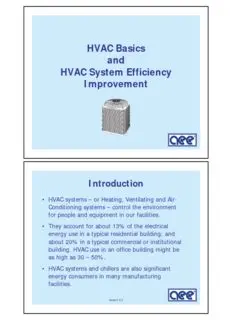
HVAC Basics and HVAC System Efficiency Improvement PDF
Preview HVAC Basics and HVAC System Efficiency Improvement
HVAC Basics and HVAC System Efficiency Improvement Introduction • HVAC systems – or Heating, Ventilating and Air- Conditioning systems – control the environment for people and equipment in our facilities. • They account for about 13% of the electrical energy use in a typical residential building; and about 20% in a typical commercial or institutional building. HVAC use in an office building might be as high as 30 – 50%. • HVAC systems and chillers are also significant energy consumers in many manufacturing facilities. Session 8.2 Functions of HVAC Systems • The purpose of a Heating, Ventilating and Air Conditioning (HVAC) system is to provide and maintain a comfortable and safe environment within a building for the occupants or for the process being conducted. • Many HVAC systems were not designed with energy efficiency as one of the design factors Session 8.3 Environmental Control Factors • An HVAC system functions to provide an environment in which these three factors are maintained within desired ranges. Typical design conditions are: • 75 degrees F temperature (dry bulb) • 40 - 60% relative humidity • ASHRAE 62.1 – 2007/2010 Ventilation Standard –17 CFM outside air per person, or –CO2 less than 1000 PPM Session 8.4 Temperature Control Strategies • Vary the temperature of the supply air to the space while keeping the air flow rate constant. This is the constant volume, variable temperature approach. • Vary the air flow rate while keeping the supply air temperature constant. This is the variable volume, constant temperature approach. VAV – variable air volume system. • Vary the supply air temperature and the flow rate, as in a variable volume reheat system. Session 8.5 Relative Humidity Control • Humidification - The air is too dry and water vapor must be added for comfort. • Dehumidification - The air is too wet and water vapor must be removed for comfort. • AC systems typically over-cool the air to remove water vapor, and then may have to heat the air back up - this is called reheat, and requires additional energy. • Either way, energy required is around 1000 Btu per pound of water. Session 8.6 Primary Equipment • Chillers • Direct expansion (DX) systems • Boilers • Furnaces Session 8.7 Secondary Systems • Single duct, single zone system • Single duct, terminal reheat system • Multizone system • Dual duct system • Single duct, variable air volume system – This is the most common system going in to large commercial buildings • Fan coil system Session 8.8 HVAC Systems The summary below illustrates the types of systems frequently encountered in heating and air-conditioning systems. VAV HVAC Systems • Most common new system going in to large commercial buildings. • High efficiency because of use of variable speed drive on the supply air fan. For example, cutting air flow from full rate to 80% of full rate, cuts the fan power almost in half! • Fan is controlled most often to keep a constant static pressure in the supply duct. Temperature is controlled by a local terminal box in the zone. Session 8.12 Power and Energy in Air Conditioning • One ton of A/C = 12,000 Btu/hour – A ton is a measure of A/C power, and is used when sizing systems, or when determining electrical demand. • One ton-hour of A/C = 12,000 Btu – A ton-hour is a measure of A/C energy, and is used when sizing storage tanks for thermal energy storage (TES) systems, or when determining electrical energy consumption. Session 8.13 Vapor Compression Cycle OUTSIDE AIR CONDENSER EXPANSION VALVE COMPRESSOR OUTSIDE AIR INSIDE AIR EVAPORATOR INSIDE AIR Session 8.14 Chiller Diagram 95 F 85 F Condenser Water Condenser Expansion Compressor Valve High Pressure Side Motor Low Pressure Side Evaporator Chilled Water 44 F 54 F Session 8.15 HVAC System Performance Measures Energy Efficiency Ratio (EER) EER = Btu of cooling output Wh of electric input = Btu/h of cooling output W of electric power input Coefficient of Performance (COP) COP = Energy or heat output (total) Energy or heat input (external only) = EER / 3.412 Btu/Wh Session 8.16 Some Magic Numbers for EER and COP EER = Btu/h of cooling output W of electric power input COP = EER /3.412 Btu/Wh X kW = 12 Ton EER Session 8.17 Sensible and Latent Heat • Sensible heat - The heat associated with a temperature change of a substance at a constant moisture level. • Latent heat - The heat associated with the phase change of a substance. • Enthalpy - Total heat content of a substance, including both sensible heat plus latent heat. Session 8.18 System Improvement Options • Make building envelope improvements to reduce HVAC load –insulation, high performance windows and roofs • Replace old HVAC units and chillers with more efficient models • Possibly downsize units and chiller –Energy Star says chillers are oversized 60% Session 8.19 • Consider multiple chillers • Consider a chiller with a variable speed drive • Consider installing a small chiller or separate HVAC system for 24/7 loads • Use VSDs on pumps, cooling towers • Replace constant volume systems with VAV - variable air volume systems Session 8.20
